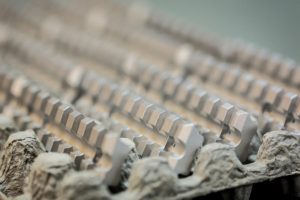How Does Bead Blasting Work?
 Bead blasting can refer to the process of sandblasting or abrasive blasting. However, in most cases, it refers to projecting media in the form of a bead or sphere against a substrate such as stainless steel, aluminum, or any material that requires a surface conditioned via blasting.
Bead blasting can refer to the process of sandblasting or abrasive blasting. However, in most cases, it refers to projecting media in the form of a bead or sphere against a substrate such as stainless steel, aluminum, or any material that requires a surface conditioned via blasting.
Most abrasive blasting is done with jagged media and leaves a “coarser” surface finish. Bead blasting refers to the use of round spherical media that, when impacted against the surface of a part, will leave a more uniform finish caused by the sphere “dimpling” the surface. This process is often used when a smooth uniform finish is required and the part must have a dull “satin” finish. The use of steel shot in this way is most often for tensile conditioning of the given substrate.
Bead blasting is the process most often used to achieve a surface finish that is both “rough” but consistent. Fine glass bead blasting is commonly used on aluminum parts that need a “dull” or “satin” finish. The coarser glass bead gives a uniform “rough” finish while masking any imperfections in the substrate surface.
Other materials such as aluminum oxide, silica carbide, or garnet, even in their finest grits, will leave any substrate it impacts with a much darker “grayer” finish. In contrast, glass bead blasting allows the substrate to maintain its base color resulting in a whiter or brighter finish.
Interested in Our Bead Blasting Services?
If you’re looking for a bead-blasted surface on your parts, you’ve come to the right place! Feel free to call us, contact RP Abrasives online, or request a quote using our quick form, and let us help you achieve your finishing goal!
